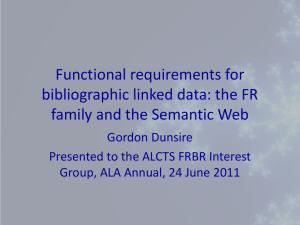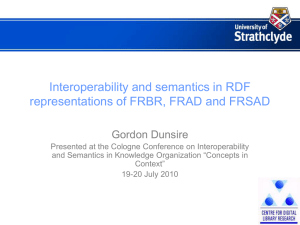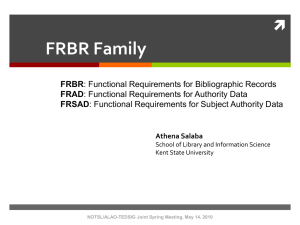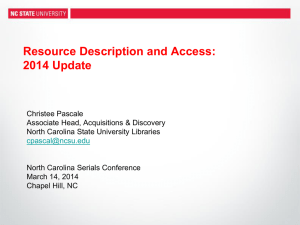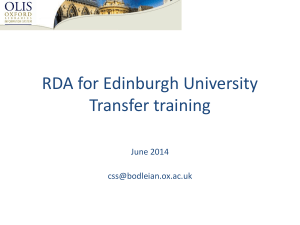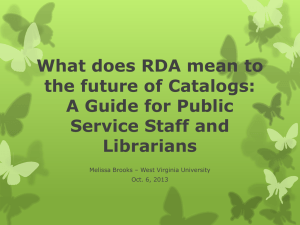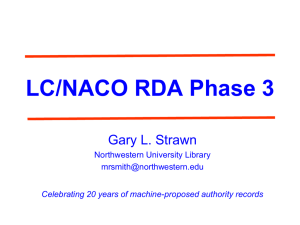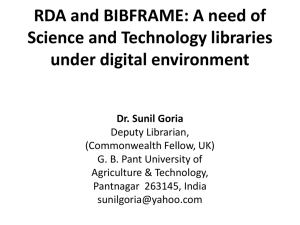Basic Overview of FRBR & RDA
advertisement
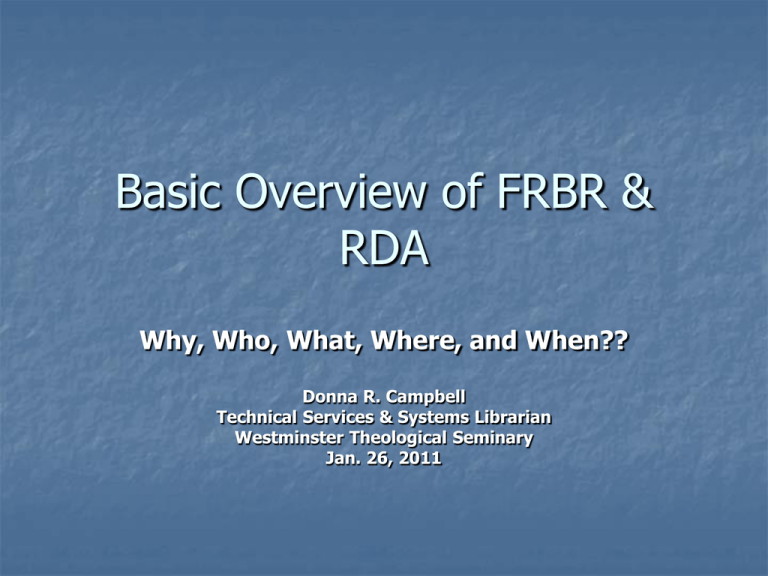
Basic Overview of FRBR & RDA Why, Who, What, Where, and When?? Donna R. Campbell Technical Services & Systems Librarian Westminster Theological Seminary Jan. 26, 2011 FRBR & RDA WHAT is it and WHY should I care? FRBR & RDA WHAT is it and WHY should I care? FRBR (pronounced fer-ber) FRBR & RDA WHAT is it and WHY should I care? FRBR (pronounced fer-ber) = Functional Requirements for Bibliographic Records FRBR & RDA WHAT is it and WHY should I care? FRBR (pronounced fer-ber) = Functional Requirements for Bibliographic Records RDA FRBR & RDA WHAT is it and WHY should I care? FRBR (pronounced fer-ber) = Functional Requirements for Bibliographic Records RDA = Resource Description and Access FRBR & RDA First, came FRBR… FRBR & RDA First, came FRBR… Then, came RDA… FRBR & RDA First, came FRBR… Then, came RDA… FRBR and RDA are intertwined in that RDA is a set of cataloging rules based upon the FRBR conceptual model. FRBR & RDA First, came FRBR… Then, came RDA… FRBR and RDA are intertwined in that RDA is a set of cataloging rules based upon the FRBR conceptual model. In order to better understand RDA, we should get a grasp of what FRBR is. FRBR WHAT is the FRBR conceptual model? FRBR WHAT is the FRBR conceptual model? The next slide will give a brief introduction. FRBR WHAT is the FRBR conceptual model? The next slide will give a brief introduction. The video moves quickly but don’t panic, just skim to get familiar with terms and ideas. We’ll cover them later. Bram Stoker's Dracula in FRBR Terms http://www.youtube.com/watch?v=LN0vK CFsXPE FRBR & RDA The BIG question is WHY the change and WHY does it matter to me especially if I’m not a cataloger? FRBR & RDA The BIG question is WHY the change and WHY does it matter to me especially if I’m not a cataloger? Potential changes to ILS and search and retrieval differences FRBR & RDA The BIG question is WHY the change and WHY does it matter to me especially if I’m not a cataloger? Potential changes to ILS and search and retrieval differences Simplify (cut cost) in the cataloging sharing environment especially the digital environment Everyone Everyone Changes in searching techniques to glean more information Everyone Changes in searching techniques to glean more information Interpreting the search results Administrators Administrators Changes in job descriptions for traditional catalogers and metadata catalogers (AACR2 knowledge as well as RDA) Administrators Changes in job descriptions for traditional catalogers and metadata catalogers (AACR2 knowledge as well as RDA) Provide training for the major changes in cataloging rules WHEN did FRBR come about? 1998, Way Back When… International Federation of Library Associations and Institutions (IFLA) Final Report on Functional Requirements for Bibliographic Records (FRBR) International cataloging principles and standards were developed over time in a different environment. How Was It Different? How Was It Different? 1. An age before automated and integrated library systems such as TLC, III Millennium, ExLibris Voyager, Horizon, and SIRSI Unicorn. How Was It Different? 1. 2. An age before automated and integrated library systems such as TLC, III Millennium, ExLibris Voyager, Horizon, and SIRSI Unicorn. An age before national and international large-scale databases (e.g., OCLC), where thousands of libraries contribute catalog records. How Was It Different? 1. 2. 3. An age before automated and integrated library systems such as TLC, III Millennium, ExLibris Voyager, Horizon, and SIRSI Unicorn An age before national and international largescale databases (e.g., OCLC), where thousands of libraries contribute catalog records. Furthermore, it was an age prior to shared cataloging…each library did original cataloging for each book. Indiana catalogers did not borrow cataloging from Pennsylvania catalogers much less Australia. How Was It Different? 4. Increased need to reduce cataloging costs by decreasing duplicate cataloging and simplifying the cataloging process due to economic pressures and increase in publications. How Was It Different? 5. Coupled with the increase in publications and need for simplification of cataloging rules, has been the advent of new formats of publications coming at us with increased rapidity as well as the use of information sources that are networked and licensed (i.e., more and more complexity and labor time) How Was It Different? 6. The changing environment includes user expectations and needs. How To Adapt To Changing Environment? How To Adapt To Changing Environment? FRBR was born-- How To Adapt To Changing Environment? FRBR was born-Beginning in 1990 with international reviews and comments and ending with the Final Report in 1998, IFLA constructed a framework of the goals of a bibliographic record and what a basic record should look like in this present age with the aforementioned changes in mind. This is how FRBR came about. WHAT is FRBR? WHAT is FRBR? More user-focused rather than formatfocused WHAT is FRBR? More user-focused rather than formatfocused Entity-relationship conceptual model WHAT are Users? WHAT are Users? Not just as library patrons but users outside the traditional library such as publishers and retailers. How is FRBR more user-focused? Functional requirements for bibliographic records are defined in relation to four user tasks. Four User Tasks 1. Find Four User Tasks 1. 2. Find Identify Four User Tasks 1. 2. 3. Find Identify Select Four User Tasks 1. 2. 3. 4. Find Identify Select Obtain Four User Tasks 1. 2. 3. 4. Find: Users use bibliographic records to find materials that correspond to their search criteria such as a specific title or all information sources covering a desired subject matter. Identify Select Obtain Four User Tasks 1. 2. 3. 4. Find Identify: Users use the retrieved data in bibliographic records to identify an entity. That is, the user uses the data in the record to confirm that is the information source he wants. Example: User can distinguish between two records that have same title but different texts. Select Obtain Four User Tasks 1. 2. 3. 4. Find Identify Select: Users use the retrieved data in bibliographic records to select an entity that is appropriate to his needs. Example: Select a text that is in the language he desires. Obtain Four User Tasks 1. 2. 3. 4. Find Identify Select Obtain: Users use the retrieved data in bibliographic records to acquire or obtain access to the entity described. Examples: to retrieve it from the library shelf, to place an ILL request, to access the full text online) WHAT is an entity-relationship conceptual model? WHAT is an entity-relationship conceptual model? Important FRBR terminology includes: WHAT is an entity-relationship conceptual model? Important FRBR terminology includes: Entities WHAT is an entity-relationship conceptual model? Important FRBR terminology includes: Entities Attributes WHAT is an entity-relationship conceptual model? Important FRBR terminology includes: Entities Attributes Relationships WHAT are Entities? WHAT are Entities? Three Groups of Entities: WHAT are Entities? Three Groups of Entities: Group I Entities: The products of intellectual or artistic endeavor that are named or described in bibliographic records: WHAT are Entities? Three Groups of Entities: Group I Entities: The products of intellectual or artistic endeavor that are named or described in bibliographic records: Work WHAT are Entities? Three Groups of Entities: Group I Entities: The products of intellectual or artistic endeavor that are named or described in bibliographic records: Work Expression WHAT are Entities? Three Groups of Entities: Group I Entities: The products of intellectual or artistic endeavor that are named or described in bibliographic records: Work Expression Manifestation WHAT are Entities? Three Groups of Entities: Group I Entities: The products of intellectual or artistic endeavor that are named or described in bibliographic records: Work Expression Manifestation Item Group I Entities are what you saw in the Dracula video WHAT are Entities? Group II Entities: Those entities responsible for the intellectual or artistic content, the physical production and dissemination, or the custodianship of such products: WHAT are Entities? Group II Entities: Those entities responsible for the intellectual or artistic content, the physical production and dissemination, or the custodianship of such products: Person WHAT are Entities? Group II Entities: Those entities responsible for the intellectual or artistic content, the physical production and dissemination, or the custodianship of such products: Person Corporate body WHAT are Entities? Group III Entities: Set of entities that serve as the subjects of intellectual or artistic endeavor: WHAT are Entities? Group III Entities: Set of entities that serve as the subjects of intellectual or artistic endeavor: Concept WHAT are Entities? Group III Entities: Set of entities that serve as the subjects of intellectual or artistic endeavor: Concept Object WHAT are Entities? Group III Entities: Set of entities that serve as the subjects of intellectual or artistic endeavor: Concept Object Event WHAT are Entities? Group III Entities: Set of entities that serve as the subjects of intellectual or artistic endeavor: Concept Object Event Place Again, WHAT is an entityrelationship conceptual model? Again, WHAT is an entityrelationship conceptual model? FRBR maps out relationships between these groups of entities Again, WHAT is an entityrelationship conceptual model? FRBR maps out relationships between these groups of entities Ex. Group I to Group II Again, WHAT is an entityrelationship conceptual model? FRBR maps out relationships between these groups of entities Ex. Group I to Group II FRBR maps out relationships between entities in the same Group Again, WHAT is an entityrelationship conceptual model? FRBR maps out relationships between these groups of entities Ex. Group I to Group II FRBR maps out relationships between entities in the same Group Ex. Group I Work to Group I Expression Back to Group I Entities Work Expression Manifestation Item Bram Stoker's Dracula in FRBR Terms http://www.youtube.com/watch?v=LN0vK CFsXPE WHAT are Attributes? WHAT are Attributes? Each Entity has logically-defined Attributes WHAT are Attributes? Each Entity has logically-defined Attributes Examples: WHAT are Attributes? Each Entity has logically-defined Attributes Examples: Attributes of a work include title of the work, date of the work, intended audience, etc. WHAT are Attributes? Each Entity has logically-defined Attributes Examples: Attributes of a work include title of the work, date of the work, intended audience, etc. Attributes of an expression include title of the expression, date of the expression, language of the expression, etc. WHAT are Attributes? Each Entity has logically-defined Attributes Examples: Attributes of a work include title of the work, date of the work, intended audience, etc. Attributes of an expression include title of the expression, date of the expression, language of the expression, etc. Attributes of a person include name of person, birth and death dates of person, etc WHAT are Relationships? WHAT are Relationships? FRBR is an entity-relationship model WHAT are Relationships? FRBR is an entity-relationship model The FRBR model maps out the relationship between the different entities and attributes that are relevant to the four user tasks. WHAT are Relationships? FRBR is an entity-relationship model The FRBR model maps out the relationship between the different entities and attributes that are relevant to the four user tasks. It’s a model that can be applied to ILS database structures. Application of FRBR Still in the developmental stages of how the FRBR model can be applied to help users. Application of FRBR Still in the developmental stages of how the FRBR model can be applied to help users. VTLS Virtua is one example VTLS = vendor Virtua = software VTLS Virtua In a demo of this product, William Denton, Web Librarian at York University, reports that a search for “adventures of tom sawyer” generates 3 records along with a link to generate a FRBR display: VTLS Virtua Clicking the FRBR Display link you see this: WHAT is RDA? WHAT is RDA? Originally dubbed AACR3, to show new edition of AACR2, the title was changed to RDA to signify the radical and global shift in cataloging rules. WHAT is RDA? Designed to apply the FRBR conceptual model WHAT is RDA? Designed to apply the FRBR conceptual model Designed to simplify cataloging code WHAT is RDA? Designed to apply the FRBR conceptual model Designed to simplify cataloging code Designed to establish it as a content standard for various metadata schema More re-use of metadata WHAT is RDA? Designed to apply the FRBR conceptual model Designed to simplify cataloging code Designed to establish it as a content standard for various metadata schema More re-use of metadata Designed for the digital/online environment WHAT is RDA? Designed to apply the FRBR conceptual model Designed to simplify cataloging code Designed to establish it as a content standard for various metadata schema More re-use of metadata beyond libraries Designed for the digital/online environment Improve organization and access in this changing environment NEWS As of Dec. 31, 2010, the RDA test period ended. A decision whether to implement RDA in the U.S. is scheduled to be made no later than June 2011. WHAT do we do now? WHAT do we do now? What will happen to all of the catalog records we currently have? WHAT do we do now? What will happen to all of the catalog records we currently have? Should we change from AACR2 to RDA? WHAT do we do now? What will happen to all of the catalog records we currently have? Should we change from AACR2 to RDA? How can we obtain training for RDA? WHAT do we do now? What will happen to all of the catalog records we currently have? Should we change from AACR2 to RDA? How can we obtain training for RDA? What are the FRBR plans for our ILS? WHAT do I do now? What will happen to all of the catalog records we currently have? Should we change from AACR2 to RDA? How can we obtain training for RDA? What are the FRBR plans for our ILS? How can our library utilize FRBR to benefit our patrons? Assurances & Suggestions Years of cataloging will be honored (i.e., no massive retrospective conversion) Assurances & Suggestions Years of cataloging will be honored (i.e., no massive retrospective conversion) Investigate VTLS’s “FRBR Software as a Service.” Assurances & Suggestions Years of cataloging will be honored (i.e., no massive retrospective conversion) Investigate VTLS’s “FRBR Software as a Service.” Investigate VTLS’s RDA Sandbox! product. Assurances & Suggestions Years of cataloging will be honored (i.e., no massive retrospective conversion) Investigate VTLS’s “FRBR Software as a Service.” Investigate VTLS’s RDA Sandbox! product. Attend SEPTLA Meeting, May 9 and RDA Workshop, May 10. Remember that the changes are not as scary as they seem!

